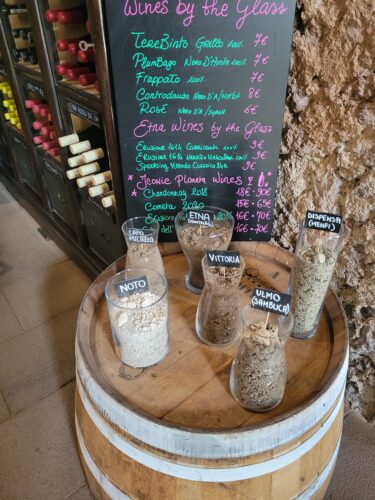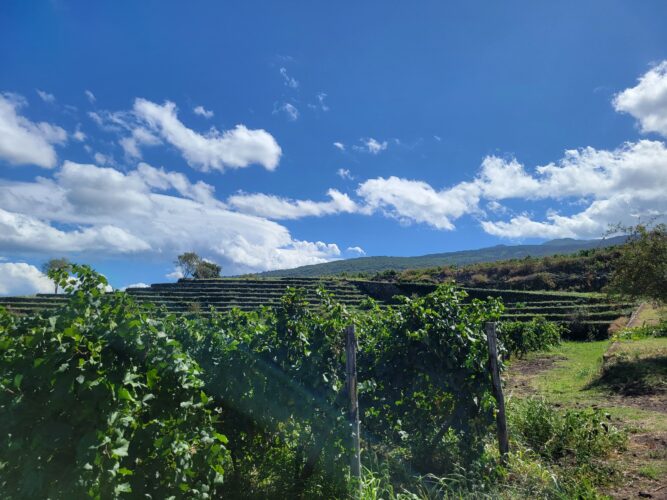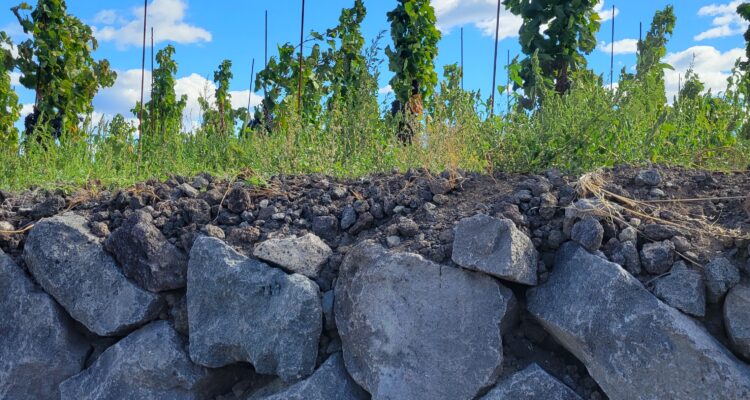I haven’t been this carried away by any white wine since the first night I started my wine journey, decades ago, with a different white wine. What’s my new crush? Carricante, the complex white wine from the slopes of Mount Etna in Sicily.
An invitation to participate in “Etna Days” meant I’d get to spend the week on an active volcano. However, the purpose of this event was not to climb the mountain. It was to sample many of the finest wines in Sicily, which are now grown on Mount Etna’s mineral-rich slopes.
I say “now” because during most of the 19th and 20th centuries, Etna wines were produced with quantity as their objective – as were most Sicilian wines. The wines were exported to the mainland of Italy and to other European countries. They were often added to other region’s wines unofficially, for color, body, bulk, or whatever was needed.
This state of affairs lasted until the end of the 20th century, when several of the top Sicilian wine producers (think Donnafugata, Planeta, Tasca d’Almerita) got together and decided to prove to the world that Sicily could also produce high quality wines for an international market. Which did, in fact happen, – after a number of years of hard work, investing vineyard and vinification processes, and promoting the wines through wine and lifestyle media.
Fast forward another decade, and these same innovative wine producers began to (re)discover the unique terroir of Mount Etna. In the early years of the 21st century, a few winemakers – many considered kind of crazy – had moved to the area, purchased vineyards and established small commercial wineries on the hillsides of Mount Etna. The rest of the mountain’s vineyards simply continued to supply wines for households and local villages.
But when winemakers from the rest of Sicily tasted the wines made by these new – shall we call them “idiosyncratic” – producers, there was an immediate land grab by established producers from the rest of the island, and even some from the Italian mainland and further abroad. In a very few years, there were hardly any small family vineyards left.
On my trip, I got to sample the result of quality producers making wine in an extraordinary terroir, often through “heroic viticulture” on steep and rocky mountain slopes, with diverse ages of lava flows through what are now vineyards, releasing their minerals to fuel the grapes.
Such a large percentage of the wines from Mount Etna I tried are fine and complex; they may also be approachable and ageable. I was not surprised to find this reflected in their price; Etna wines do command premium prices.
Red wines have tended to dominate in both quantity and quality, in southern wine producing regions like Sicily. But are we really in Sicily here? Remember, we’re on a mountain. Mount Etna is the tallest active volcano in Europe, and it perches on the edge of the Ionian Sea – a climatic influence that also contributes to the singular character of its wines. The mountain itself is about 11,000 feet (3300 meters) high, though that number does vary after eruptions, the most recent being just last summer when an ash plume interrupted nearby plane flights.
In terms of altitude, most vineyards aren’t planted above 3,300 feet (1,000 meters) which is near the upper border of Etna DOC (Denominazione di Origine Controllata), the official delimited region.
 Far from being homogeneous, they vary with the soil type where the grapes are grown, which is a direct result of how long ago the earth of their vineyards had spewed out of the mountains (some thousands of years ago, some maybe a hundred years ago). Different eruptions added different types of lava to the mix. And the rock-studded carpet of lava spewed out of the volcano takes time to decompose, which gradually alters the earth the vines grow in. The vineyards’ locations are also significant, as well as the orientation of the rows of grapevines. The Etna DOC appellation includes wines grown on the south, east and northern slopes of the mountain.
Far from being homogeneous, they vary with the soil type where the grapes are grown, which is a direct result of how long ago the earth of their vineyards had spewed out of the mountains (some thousands of years ago, some maybe a hundred years ago). Different eruptions added different types of lava to the mix. And the rock-studded carpet of lava spewed out of the volcano takes time to decompose, which gradually alters the earth the vines grow in. The vineyards’ locations are also significant, as well as the orientation of the rows of grapevines. The Etna DOC appellation includes wines grown on the south, east and northern slopes of the mountain.
WHITE WINES: Recently, I’m seeing an increasing fascination with white wines everywhere, reflecting my own experience.
On Etna, I decided to concentrate on the finer level wines, designated Etna DOC Bianco Superiore, and I was very pleased to discover many excellent wines. They tend toward a golden color, and most are medium-bodied though some are lifted, lighter). They are made with 80-100% carricante; catarratto and/or minello can be added.
Here are top picks for recent vintages in this category, in alphabetical order
Azienda Agricola Calgano, Primazappa; Barone di Villagrande; Cantine di Nussuno, Milus; Contrada Volpare; Cantine Edomé, Aitna bianco; Cantina IUPPA, Lavi and Linod; Federico Kurtaz, Kudos; I Custodi delle Vigne dell’Etna, Imbris; Maugeri, Volpare Frontebosco and Volpare Frontemare; Sive Natura, Biancomura di Casselle; Tasca d’Almerita, Tenuta Tascante Sciarnuovo; Tenuta di Fessina A’Puddara; Theresa Eccher, Sole di Sud Ovest.
I’d also like to mention two additional, lovely Etna DOC Bianco wines I tasted on the mountain: Donnafugata’s Sul Vulcano, with flavors of light white fruits, and Duca di Salaparuta’s Lavico Bianco, quite full on the palate.
THE TAKEAWAY: Try the flavorful, medium-bodied, dry white wines made with the indigenous catarratto grape, grown on the mineral-rich slopes of Sicily’s Mount Etna volcano. Look for wines in the categories Etna DOC Bianco and Etna DOC Bianco Superiore.


